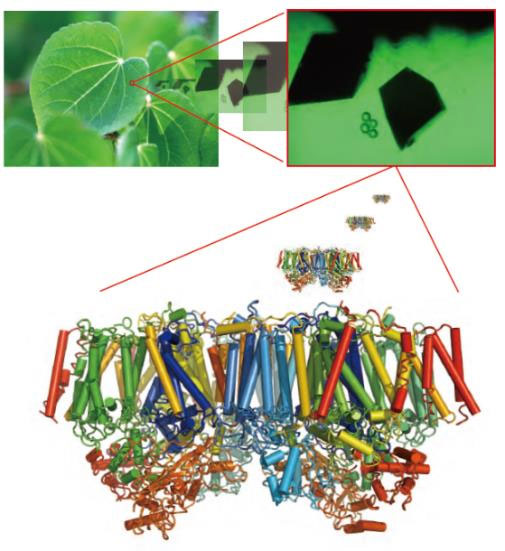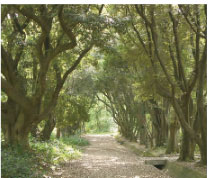Course Information
Mathematics & Physics
 The fluorescence telescopes of The Telescope Array, the world’s largest cosmic ray detector in the northern hemisphere. Fluorescence photons, a faint UV emission from air molecules, are detected when a cosmic ray strikes the atmosphere within the area of 700 km2 around the telescopes.
The fluorescence telescopes of The Telescope Array, the world’s largest cosmic ray detector in the northern hemisphere. Fluorescence photons, a faint UV emission from air molecules, are detected when a cosmic ray strikes the atmosphere within the area of 700 km2 around the telescopes.
We study and develop mathematics and physics, as well as their interface, to develop a deeper understanding of nature.
The Division of Mathematics & Physics has five courses:
(1) Mathematical Structures, (2) Mathematical Analysis, (3) Fundamental Physics, (4) Astro- and High-Energy Physics, and (5) Condensed-Matter Physics. About 50 academic staff belong to this division and provide advanced education to graduate students. Students can experience their research lives at the forefront of modern mathematics and physics in these divisions in an environment that is excellent for fostering scientists.
Courses & Research groups
- Mathematical Structures
- Algebra, Representation Theory, Manifold Theory, Topology
- Mathematical Analysis
- Real and Complex Analysis, Probability Theory, Applied Mathematics, Partial Differential Equation, Algebraic Analysis, Differential Geometry
- Fundamental Physics
- Particle Physics, Nuclear Theory, Gravitation and Astrophysics, Mathematical Physics
- Astro and High Energy Physics
- Cosmic Ray Physics, High Energy Physics, Cosmic & Experimental Particle Physics, Gravitational Wave Physics and Astrophysics
- Condensed-Matter Physics
- Ultra Low Temperature, Physics of Photophysical Properties, Physics of Biological Material and Crystal Growth, Elementary Excitation Physics, Strongly Correlated Electron System, Ultracold Quantum Gas
Molecular Materials Science
 Three-dimensional structure of a protein complex (Photosystem II). This complex is responsible for photosynthetic water splitting for the evolution of molecular oxygen that is occupying 20% of the earth's atmosphere.
Three-dimensional structure of a protein complex (Photosystem II). This complex is responsible for photosynthetic water splitting for the evolution of molecular oxygen that is occupying 20% of the earth's atmosphere.
Nowadays, we are facing the disappearance of a conventional boundary in the field of natural science and the rapid development of new fields in the advanced research area. In the field of chemistry, the science of materials, it is astonishing that the advanced knowledge is stored day by day and new interdisciplinary fields are developing rapidly. To adapt to this situation, we have established the Division of Molecular Materials Science consisting of two fields of study: Creative Molecular Science and Functional Molecular Science. Our education is aimed at understanding the diverse phenomena of materials systematically, disclosing the roles of biological materials at the molecular level, and developing novel materials with advanced functions.
In this division, 32 faculty members teach advanced scientific research in a one-to-one manner in an open, free, and international atmosphere. Many of the undergraduate students enter the master’s course after their graduation and one-fifth of the graduate students go on to pursue a doctoral degree after they complete the master’s course. They are studying higher level knowledge in molecular materials science and devote themselves to advanced research. Students who have made excellent research achievements can shorten the completion term to graduate by one to two years. We have been producing a large number of graduates who have a high level of expertise, a broad scientific perspective, and experience for the achievement of future innovations. They are leading research activities in universities, public institutes, and companies.
Courses & Research groups
- Creative Molecular Science
- Laser Chemistry, Quantum Functionality Materials, Hybrid Molecular Chemistry, Advanced Analytical Chemistry, Molecular Materials Chemistry, Molecular Physical Chemistry, Fine Organic Chemistry, Bio-functional Molecular Design
- Functional Molecular Science
- Organic Reaction Chemistry, Function Chemistry, Molecular Conversion, Synthetic Organic Chemistry, Biological Structural Chemistry
Biology & Geosciences
 left: African cichlid (Tropheus moorii) appealing their territory in Lake Tanganyika. right: Kayoso Fold at Nago City, Okinawa (a natural monument)
left: African cichlid (Tropheus moorii) appealing their territory in Lake Tanganyika. right: Kayoso Fold at Nago City, Okinawa (a natural monument)
In the Division of Biology & Geosciences, we aim to systematize new disciplines that cross the two fields centering on the global environment in the development of Biology and Geosciences. Biology is a discipline for understanding the essence of life. We aim to elucidate biological phenomena in a wide range of fields, from molecules, cells, individuals, and ecosystems to the global level. Geosciences are aimed at deciphering the history of the earth as a complex system that has changed repeatedly in order to recognize the realities of the Earth from the past to the present and to build the knowledge and technology necessary to predict its future.
Our division consists of five courses, (1) Science of Biomolecules, (2) Functional Biosciences, (3) Functional Biology of Natural History, (4) Environmental Geosciences, and (5) Earth Evolution Sciences. We aim to nurture experts of Biology and Geosciences who can analyze evolution and the life of living organisms, including humans, based on the current environment and the history of the Earth, and apply the results to environmental problems.
Courses & Research groups
- Science of Biomolecules
- Functional Biopolymer Science, Functional Biological Low Molecule Science, Functional Metabolic Regulation Science
- Functional Biosciences
- Functional Cellular Biology, Functional Plant Biology, Functional Animal Biology
- Functional Biology of Natural History
- Plant Evolution & Adaptation, Informatic Biology, Functional Plant Ecology, Functional Animal Ecology
- Environmental Geosciences
- Geological Informatics, Urban Geosciences, Natural History of Anthropogene
- Earth Evolution Sciences
- Geohistory, Petrology, Mineralogy & Geochemistry
Botanical Gardens

The Botanical Gardens were established in 1950. About 450 species of native Japanese trees were planted to replicate 11 major forest types in Japan. Other important collections include exotic trees, bamboos, aquatic plants around Osaka, and tropical/subtropical plants. The collections are provided as study material for Japanese and foreign scientists.
